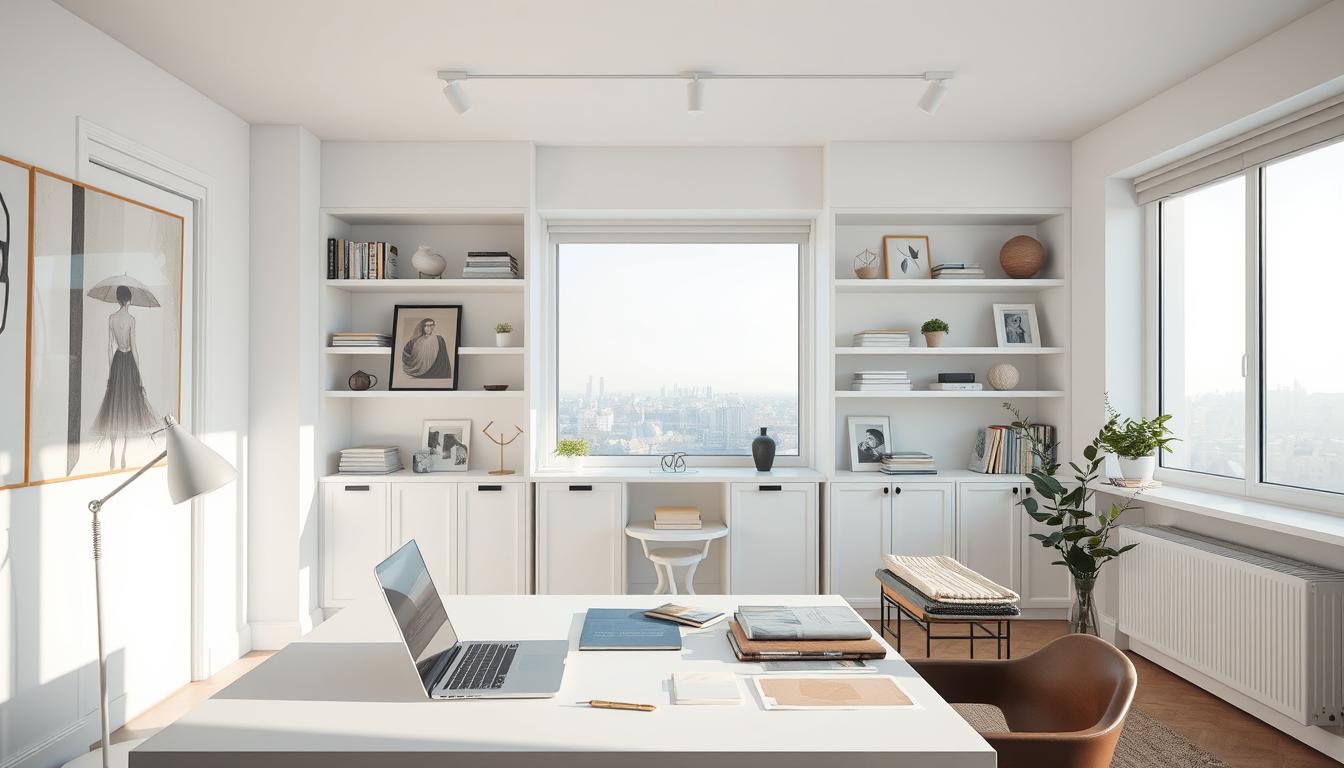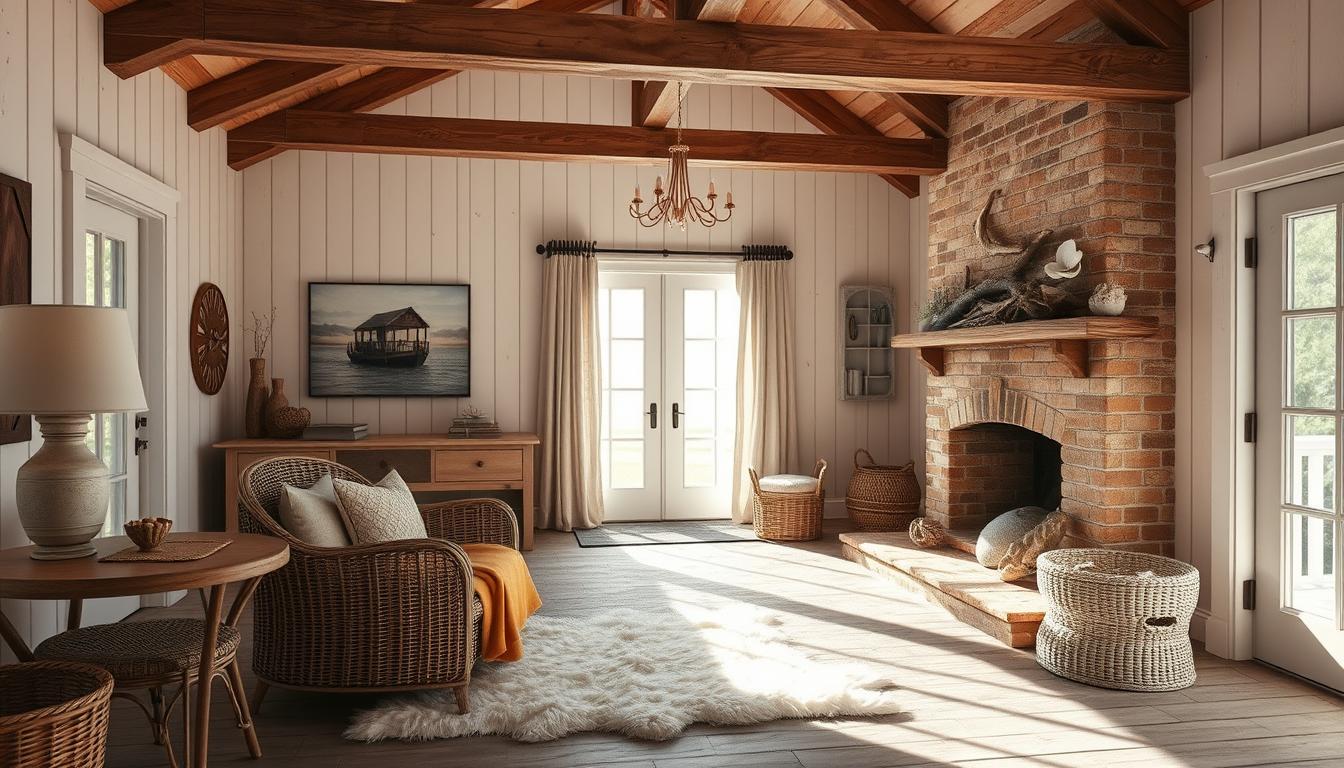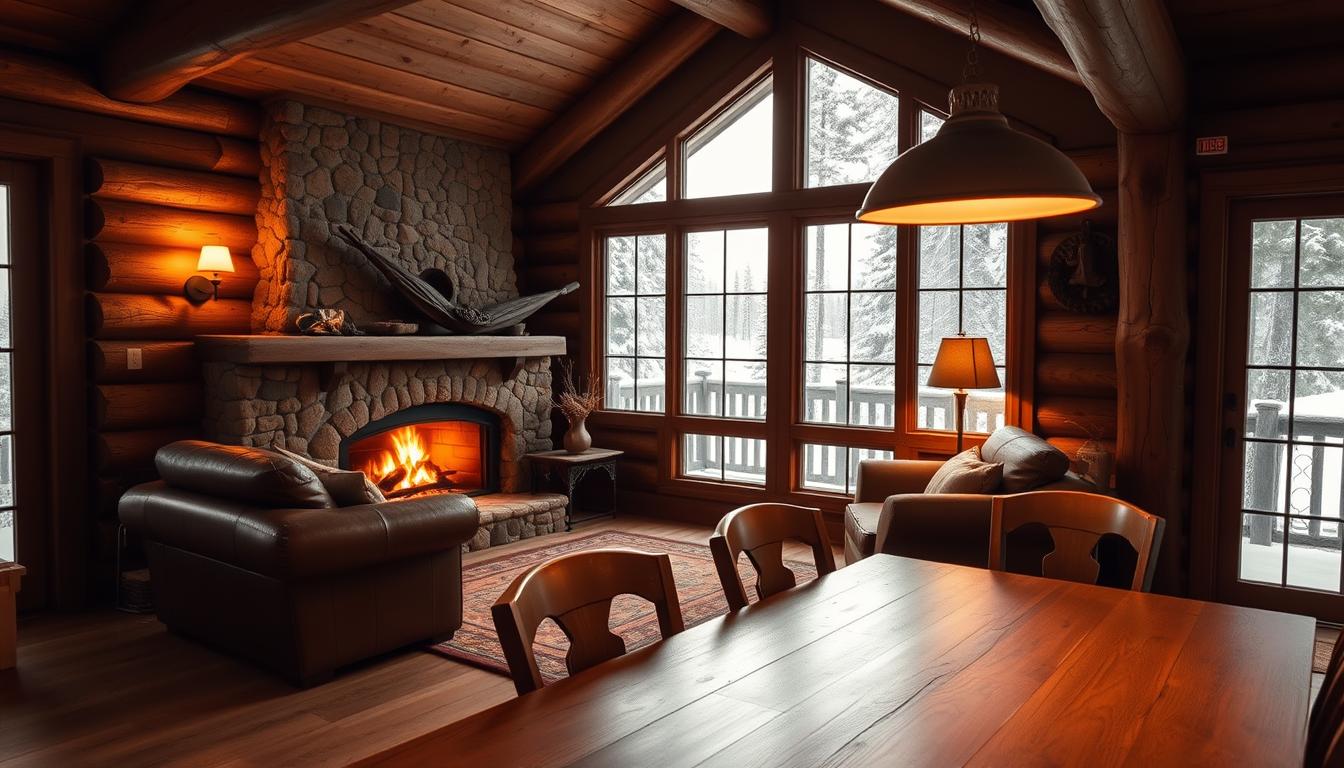Did you know that hiring a professional interior designer can increase your home’s value by up to 15%?
When planning to revamp your living space, understanding the interior design pricing is crucial.
The average interior design fees can range from $100 to $200 per hour. High-end designers can charge up to $500 per hour.
We will guide you through the factors that influence these costs. We’ll also tell you what to expect when hiring a professional.
Key Takeaways
- Average hourly rate for interior designers is between $100 to $200.
- High-end designers can charge up to $500 per hour.
- Pricing varies based on experience, location, and scope of the project.
- Understanding the scope of your project helps in estimating the total cost.
- Factors like location and designer’s reputation influence the final cost.
Understanding the Role of an Interior Designer
To budget for interior design, knowing what an interior designer does is key. They handle everything from planning spaces to picking materials. This affects the interior designer cost breakdown.
Knowing their work scope helps set a fair budget for interior design. Their skills make spaces look better and save money in the long run.
What Does an Interior Designer Do?
An interior designer’s job is big. They do several important things:
- They figure out what the client wants and needs.
- They make detailed design plans and specs.
- They pick out materials, finishes, and furniture.
- They watch over the installation and make sure it’s done on time.
By doing these things, an interior designer can really affect the project’s cost. They help make sure it fits the client’s budget for interior design.
Benefits of Hiring an Interior Designer
Hiring an interior designer has many benefits:
- They save time by handling the whole project.
- They can cut costs by planning and picking materials wisely.
- They make sure the project looks professional, which can increase the property’s value.
It’s important to know how much does an interior designer charge for budgeting. Their fees depend on their experience, where they are, and how complex the project is. But, the benefits they offer are worth more than the cost.
By choosing a professional interior designer, clients can be sure their project will be done right. It will stay within budget and meet their goals.
Factors Influencing Interior Design Costs
The cost of hiring an interior designer depends on many factors. It’s important to know what affects these costs. Several elements play a big role in the final price of an interior design project.
Location and Market Trends
The location of the project greatly influences the cost. Designers in big cities or areas with high living costs charge more. For example, a designer in New York City might charge more than one in a small town.
Market trends also affect prices. The demand for certain styles or services can increase costs.
Experts say, “The cost of living and doing business in a place affects interior design prices.” (Source)
Project Size and Complexity
The size and complexity of the project also matter. Bigger homes or more complex projects need more time and resources. This increases the cost.
A full-service design for a large luxury home costs more than a smaller project. This is because bigger projects need more materials and labor.
- Larger projects require more materials and labor, increasing costs.
- Complex projects, such as those involving custom designs or high-end finishes, demand more time and expertise from the designer.
Designer Experience and Reputation
The experience and reputation of the designer also affect the cost. More experienced designers or those with a strong reputation charge more. Choosing a seasoned professional can be worth it. They can provide quality designs and help avoid costly mistakes.
“A well-designed space not only enhances the aesthetic appeal of a home but can also increase its value.” – Industry Expert
Understanding these factors helps homeowners plan their interior design project better. Whether looking for affordable interior designer rates or comprehensive pricing for interior design services, being informed is key. It helps make the most of your investment.
Average Costs for Interior Design Services
When planning an interior design project, knowing the average costs is key. The cost can change a lot based on where you are, how big the project is, and the designer’s experience.
National Averages for Interior Design Fees
There are national averages for interior design fees. On average, designers charge between $100 to $200 per hour. For bigger projects, they might ask for a flat fee that can be from $2,000 to $12,000 or more.
Average Interior Design Fees:
| Service Type | Average Cost |
|---|---|
| Hourly Rate | $100 – $200 per hour |
| Flat Fee for Small Projects | $2,000 – $5,000 |
| Flat Fee for Large Projects | $5,000 – $12,000+ |
Hourly Rates vs. Flat Fees
Designers usually charge in two ways: by the hour or with a flat fee. Hourly rates are good for small projects or quick consultations. Flat fees are better for bigger, more detailed projects.
Hourly Rates: This method is flexible, but it’s hard to guess the total cost at first.
Flat Fees: With flat fees, you know the total cost right away. This is great for those who want to stick to a budget.
Costs for Different Project Types
The cost changes based on the project type. For example, a kitchen remodel needs more design work than just decorating one room.
Project Type Costs:
| Project Type | Average Cost Range |
|---|---|
| Single Room Design | $1,000 – $3,000 |
| Whole House Design | $5,000 – $20,000+ |
| Kitchen Remodel | $3,000 – $10,000+ |
Knowing these costs helps homeowners plan their interior design projects better.
Services Offered by Interior Designers
Interior designers offer a wide range of services to make spaces both beautiful and useful. When we hire them, we’re not just getting help with decorating. We’re getting a full service that covers many aspects of design.
Space Planning and Layout Design
Interior designers are experts in space planning and layout design. They look at the space we have and figure out the best way to use it. This makes rooms feel bigger, improves how we move around, and makes spaces more useful.
By thinking carefully about the layout, they help us create spaces that are both efficient and enjoyable.
Color Consultation and Materials Selection
Choosing the right colors and materials is another key service. The colors and materials we pick can greatly change how a space feels and looks. Our designers help us pick colors that match our style and the building’s design.
They also help choose materials for floors, walls, and furniture. These materials should look good and last long. This way, the final space is both beautiful and practical.
Understanding what interior designers do helps us see their value. They help with everything from space planning to picking colors and materials. Their work is crucial in making spaces that are not only nice to look at but also useful.
Additional Costs to Consider
There are more costs to think about when planning your interior design budget.
Furnishing and Decor Expenses
The cost of furniture and decor can change a lot. For example, choosing custom furniture or luxury finishes can raise your costs.
- Custom furniture
- High-end finishes
- Unique decorative pieces
As design expert Kelly Wearstler said, “The details are not the details. They make the design.”
“Good design is good business.” – Thomas Watson
Installation and Labor Costs
Don’t forget about installation and labor costs when planning your design project.
| Service | Average Cost |
|---|---|
| Electrician | $100-$300 per hour |
| Plumber | $150-$400 per hour |
| Carpenter | $75-$250 per hour |
It’s key to talk to experts to get a real estimate. Include these costs in your budget for interior design.
Pricing Models for Interior Designers
Interior designers use different pricing models. Each model has its own benefits and things to consider. It’s important for clients to know about these models to make good choices for their projects.
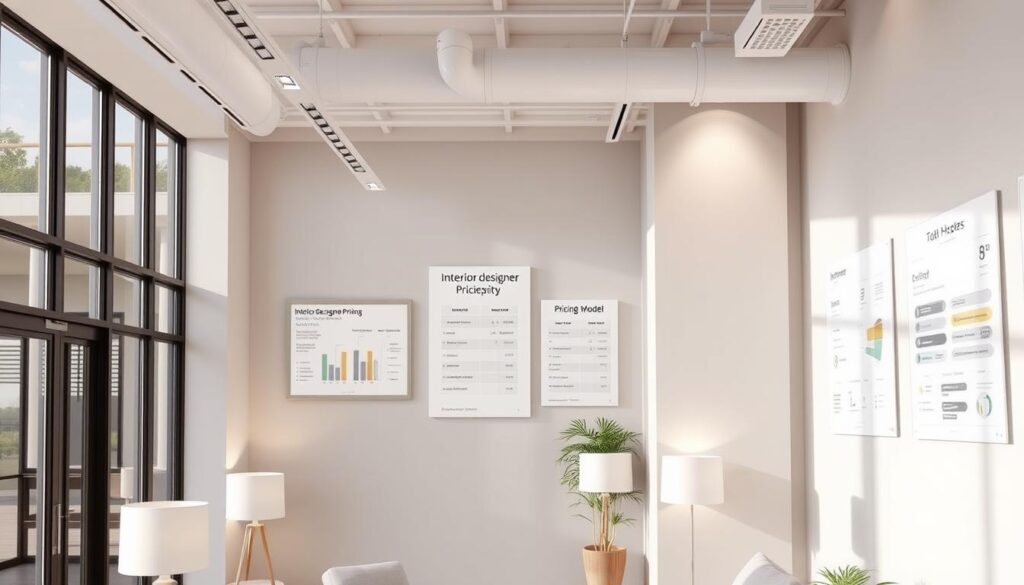
Fixed Fee vs. Percentage of Project Cost
There are two main pricing models: fixed fee and percentage of project cost. A fixed fee means paying one price for the whole project. This makes costs clear from the start.
A percentage-based fee is a percentage of the project’s total cost. This is good for big, complex projects. For example, if a project costs $100,000, a 10% to 20% fee would be $10,000 to $20,000. This fee matches the project’s size and budget.
Hourly Billing Explained
Hourly billing is when designers charge by the hour. This is often used for small projects or when the work is not clear.
The hourly rate changes based on the designer’s experience, location, and services. For example, a senior designer in a big city might charge $150 an hour. A less experienced designer in a small town might charge $75 an hour.
Many designers give detailed time sheets or updates. This helps clients see how their money is being spent.
Budgeting for Your Interior Design Project
Starting an interior design project? First, set a budget to avoid overspending. A good budget keeps you on track with your design dreams.
Setting a Realistic Budget
To set a budget, know the average interior design fees and what affects them. Look up interior design pricing in your area. Think about your project’s size, design complexity, and your designer’s experience.
Decide what you must have versus what you’d like. This helps you budget better. It lets you adjust your spending as needed.
Contingency Fund Recommendations
Unexpected costs can pop up in any project. Set aside 10% to 20% of your budget for surprises. This is your contingency fund.
This fund keeps you calm and ready for any extra costs. It covers things like structural fixes, material price changes, or other surprises.
With a smart budget and a contingency plan, your project will stay financially sound. This way, you can reach your design goals without spending too much.
Hidden Costs in Interior Design
Interior design projects often have hidden costs that can surprise clients. The first quote might seem complete, but extra expenses can pop up. These can include fees for changes, rush orders, or extra consultations.
To avoid surprises, it’s key to know the hidden costs of interior design. These can include fees for changes, rush orders, or extra consultations not in the budget.
Understanding Additional Fees
Extra fees can come from many parts of the design process. For example, revisions to the initial design plan can cost more. Clients should know that many changes can increase the designer’s fees.
- Rush orders for materials or furniture can also lead to additional expenses.
- Consultation fees for services like color consultation or materials selection might not be included in the initial quote.
- Travel fees for designers who charge for travel time or expenses.
Knowing about these extra fees is key to a realistic budget for your design project. By understanding these costs, clients can plan better and avoid surprises.
Avoiding Unforeseen Expenses
To avoid unexpected costs, clients should clearly communicate their needs and expectations to the designer. This means being clear about the project’s scope and any possible changes.
- Request a detailed breakdown of the costs involved in the project.
- Understand the designer’s fee structure, whether it’s hourly, flat fee, or a percentage of the project cost.
- Plan for contingencies by setting aside a portion of the budget for unexpected expenses.
By following these steps, clients can manage their budget and expectations better. This makes the interior design process smoother.
When looking at “pricing for interior design services,” remember the value a designer adds. The cost might seem high, but the long-term benefits and savings are worth it.
Knowing “how much does an interior designer charge” helps clients plan their budget better. Being aware of potential costs and hidden fees lets clients stay within budget.
How to Find the Right Designer for Your Budget
Finding the right interior designer is key to a successful project. You need someone who understands and works within your budget. With the right approach, you can find a professional who meets your financial needs and brings your design vision to life.
Researching Potential Designers
Start by researching potential designers. Look online, check social media, and ask for referrals. Find designers with experience in projects like yours and check their portfolios for style and quality.
Consider their location, reputation, and services. Also, read reviews and testimonials from past clients. Affordable interior designer rates vary, so know what you’re looking for.
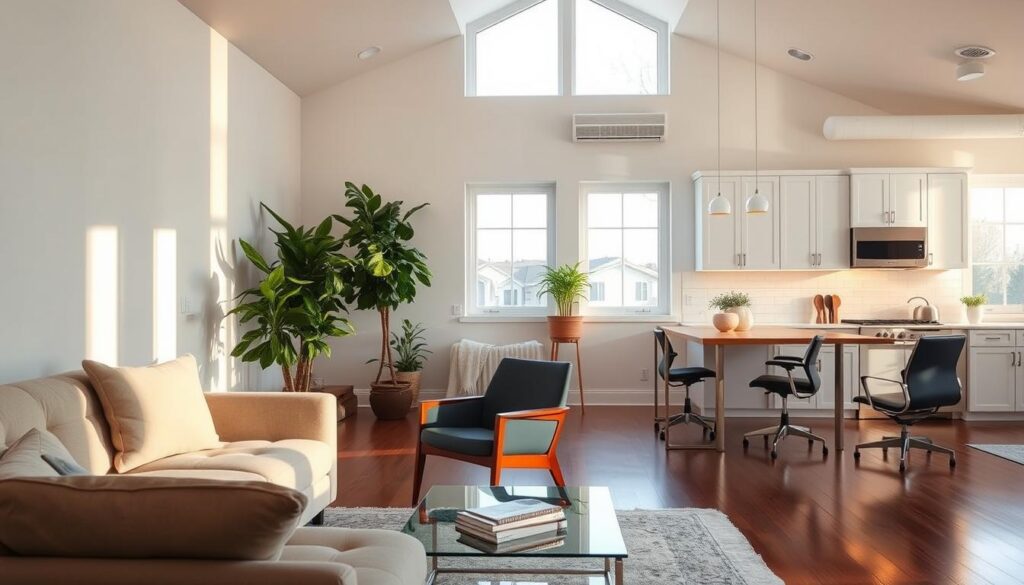
Interviewing Candidates Effectively
Once you have a list of designers, it’s time to interview them. Prepare questions about their experience, design philosophy, and budget handling. Ask how they create a budget for interior design that fits your expectations.
Listen to how well they understand your needs and communicate their ideas. Discuss interior design pricing models early to avoid misunderstandings. Effective interviews help you choose a designer who fits your budget and design dreams.
Negotiating the Cost with Your Designer
Talking about cost with your interior designer can seem tough. But, with the right strategy, you can find a deal that works for both of you. It’s not just about cutting costs. It’s about seeing the real value your designer adds to your project.
Tips for Effective Communication
Good communication is key to successful talks. When you’re discussing costs, be clear about your budget and what you want. Here are some tips to help you communicate well:
- Share your budget limits and what you hope to achieve.
- Ask for a detailed interior designer cost breakdown to see where your money goes.
- Talk about what matters most to you and see if costs can be cut without losing your vision.
Knowing how much does an interior designer charge helps you negotiate better. Learn about average costs for interior design in your area. This way, you can make smart choices.
Understanding the Value of Quality Work
The cost of hiring an interior designer shows the quality you’ll get. While cheaper options might seem appealing, think about the long-term benefits of quality design. A skilled designer can make your space look better and work better, possibly even increasing its value.
When you’re talking about pricing for interior design services, think about the work, the designer’s experience, and the materials needed. Knowing these details helps you get a fair price that matches the value you’re getting.
In short, negotiating with your interior designer needs good communication, understanding costs, and valuing quality work. Being informed and open can lead to a deal that fits your budget and needs.
The ROI of Hiring an Interior Designer
Professional interior design services offer a big return on investment. Homeowners who hire an interior designer get more than just good looks. They invest in their space’s long-term value and function.
Long-Term Value of Professional Design
An interior designer does more than pick furniture and colors. They create a space that looks great and works well. This can make life better for those living there and even increase the home’s value.
A well-designed interior can last longer and cost less to maintain. Smart choices in materials and finishes can save money on repairs and replacements later.
Enhancing Property Value Through Design
A stylish home can sell for more money. Studies show that interior design can bring a big return when selling a property.
Here’s a table showing the average return on investment for different design projects:
| Project Type | Average Cost | Average ROI |
|---|---|---|
| Kitchen Remodel | $20,000 – $50,000 | 80% – 120% |
| Bathroom Renovation | $10,000 – $30,000 | 70% – 100% |
| Interior Painting | $2,000 – $5,000 | 50% – 80% |
In summary, hiring an interior designer can bring a big return on investment. This comes from the lasting value of professional design and the chance to increase property value. Knowing the costs and benefits helps homeowners make smart choices for their interior design projects.
Conclusion: Making the Most of Your Investment
Understanding the costs of hiring an interior designer helps us make smart choices. A good budget is key to getting the look we want. It ensures our interior design project goes smoothly.
Practical Considerations
When planning our interior design, we must think about the costs. This includes the designer’s fees, materials, and labor. Knowing these costs helps us plan better.
With a clear budget, we can start our interior design journey with confidence. We’ll get a beautiful space that meets our needs and increases our property’s value.

